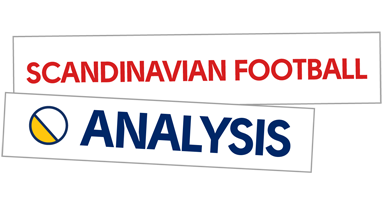In recent weeks it was announced that Sandefjord would not renew the contracts of head coach Martí Cifuentes and his coaching team. When looking at the results, this was a surprising move as they arguably have overachieved in the current campaign. Sandefjord has performed to a high standard all season while playing entertaining football. A coach who can produce these results will most likely have offers from traditionally bigger clubs, both domestic and abroad.
Cifuentes is a Spanish international with recent coaching experience in Scandinavia, in both Sweden and Norway. It is natural to also assume that Danish clubs are keeping up with news around his situation.
This data analysis will look at selected statistics from the three Scandinavian leagues mentioned, while also adding the Belgian, Dutch, Swiss and Austrian leagues as a potential step up in league quality, to see which clubs might benefit from considering Cifuentes. Following this, the clubs that come out as potential candidates will go through an analysis and be narrowed down by looking at which of them have a recent history of giving the reins to younger coaches with less experience in top-level football.
Eagerness to regain and pass to progress
The first data to look at will be a combination of two statistics to present a picture of pressing and passing tendencies. It utilises challenge intensity to show how much a team presses to regain the ball when the opponent is in the possession and passing rate to present a picture of passing tendencies; how many passes per minute of possession.
The further to the top a club is placed in the scatter plot, the more aggressive or intense their pressing is. At the same time, the further to the right it is placed, the more their game is geared towards passing over carrying, and to some degree a larger portion of shorter passes. A team then in the top right corner, like Ajax or RB Salzburg press intensively to regain the ball and employ a large number of short passes when in possession.
In the scatter plot below, Cifuentes’ current club is shown in red with a blue line. The marker for Sandefjord is situated some way to the left, indicating a tendency towards fewer passes per minute. This can be either more carrying actions or more direct/longer passes.
At the same time, Sandefjord is placed fairly average on a European standard when it comes to challenge intensity, a statistic which specifically looks at the number of defensive actions per minute of opponent possession. Clubs with similar statistics are marked, alongside certain clubs to act as reference points.
It is fair to point out that Sandefjord played in the Norwegian second division last season and was tipped by most pundits to be lucky to stay in the division this season. They have, as stated in the intro, outperformed those expectations and are currently on route to a mid-table finish.
Thus, a mid-table finish by a newly promoted team, tipped for a relegation battle and with limited funds suggest that habits the team have formed in training are able to produce actions and results in matches that are more than the sum of its parts.
Aerial battles and directness
The next set of data looks at the frequency of aerial duels per 90 minutes and accurate passes to the final third. Frequency of aerial duels may say something about the general style of the team, and how this style is imposed on any given opponent in matches. A high number here indicates a team that plays more lofted passes, play an aggressive press that forces lofted passes or both.
Accurate passes to final third present a picture of how effective a team is in progressing the ball into the final third. A high number indicates a team that is able to continuously find players ahead in the field and continue attacks from there, or playing deep passes on the counter when there is more space.
A lower number might suggest that a team plays a lot of high-risk, vertical passes, is inefficient at finding players ahead, or both. As a team lower in the middle to lower half of the table, Sandefjord build-up from the back is often under high pressure, and they play more direct passes on one or two touches in their own half.
While being fairly poor with their accuracy in final third passes, Sandefjord has an exceptionally low number of aerial duels per 90 minutes. Despite playing more direct and/or poorer passes vertically, they keep the ball on the ground. This suggests that a certain degree of verticality exist in their passing play, and not necessarily seeking to always take advantage of playing over a high line.
Employing young managers and coaches
There are advantages to employing both older and younger managers and coaches. Youth might not automatically mean inexperience, and being older does not mean a coach does not update his or her model and ideas to modern and current trends. One big advantage with coaches of younger age is that they are more recently educated, and thus might have a more modern approach to the game and training. Incorporating more fields of science into everyday life, modern leadership styles and science-based football training principles might be some.
Another big reason to higher a young coach, either for the senior team or a youth team, is that he or she is easier to mould into the club’s profile and can be developed to one day potentially take over the first team, much like Julian Nagelsmann were at Bundesliga side Hoffenheim.
This section will look at five clubs specifically that hits the criteria of being in relatively close distance to Sandefjord in certain stats shown above, while also having a recent history of employing younger and/or less experienced coaches at the top level of senior football. First out are three clubs at a slightly higher level than Sandefjord and the Norwegian Eliteserien. Then, one club with a lower probability for looking at Cifuentes, and finally a wildcard which could be very interesting.
FC Groningen
The club from the north of the Netherlands is similar to Sandefjord in several statistics. Passing rate and challenge intensity are almost identical. Sandefjord is slightly more passing oriented, while Groningen is just ahead when it comes to the pressing. A larger proportion of Groningen’s matches are in the air, with 38.77 aerial duels per 90 compared to Sandefjord’s 28.68. At the same time, the Dutch are more efficient in entering the final third, with their 65.8% being of European average standard. Sandfjord’s 59.5 is as mentioned quite poor compared to the rest of the continent.
The last three coaches at Groningen have been younger or just passed 40 years old when being offered the job. Danny Bluijs, Ernest Faber and Erwin van de Looi, were all at the start of their senior football coaching careers when accepting the head coach position. Cifuentes fits both descriptions, but the one he does not fit is that all three of them are Dutch, and he does not speak the language.
AC Horsens
Horsens were promoted last season after three years at the second level in Denmark. They are yet to win a game this season with nine games played. Reaching the play-off with the top half of the table looks very unlikely at this stage, and if nothing changes soon, the board will eventually start looking at the coach as is the norm in football. This is something familiar for Cifuentes as it is similar to the situation when he took over Sandefjord. He wasn’t able to keep the club in the top division, but significantly improved them the next season and laid the groundwork for a good 2020 season.
Horsens are also accustomed to a similar playing style (according to the data) as Sandefjord. Showing higher numbers in both passing rate and challenge intensity, but a significantly larger portion of aerial duels per 90, almost double, with 50.35. At the same time, they can show better accuracy towards the final third than Groningen and Sandefjord, which might then prove a marginally bigger challenge if they were to look at Cifuentes as a replacement. Both the current coach, Jonas Dal, and the previous one, Bo Henriksen were relatively young when getting appointed.
TSV Hartberg
This Austrian team played their first-ever top-flight football in the 2018-19 season and followed that up with reaching a fifth-place last season, securing a place in UEFA Europa League qualifiers. Currently in relegation play-off spots but close to the championship play-off. Very similar to Sandefjord in all four measurements, signalling that come the next summer, Cifuentes might find someone they could look at if a change of head coach is on the cards.
There is a trend ongoing with most clubs employing young coaches, and that is that they often employ the ones with the same nationality as the country they play in. TSV are no different, with both Markus Schopp and Christian Ilzer being Austrian and therefore speakers of the German language. This is often a requirement with German-speaking clubs that the coach must speak it already or learn it quickly. Implementing his own variation on a familiar style could prove more difficult with communication issues at the same time.
FC Midtjylland
The Danish money ball team are getting a lot of attention in modern football, with an immense focus on data and science to get ahead of the competition. This is a team with the last four coaches all being either a part of the Midtjylland system before being offered the job or working with the Danish youth national teams. This suggests trust in both youth/inexperience and a long-term vision for their football. They are all Danish, but with a coaching career taking him to both Sweden and Norway, Cifuentes will already have some knowledge of the language.
Midtjylland is a more aggressive team in the press than Sandefjord and has a slightly more passing oriented approach in their games. They are on the same level of accuracy with final third entries as the three above, but closer to Sandefjord in the number of aerial duels, as Groningen.
The differences in numbers could be down to a qualitative difference, as Midtjylland are one of the better teams in the league. Their model has helped them to the top of Denmark and to the group stages of the UEFA Champions League ,and it could be an interesting option to look towards another young coach with Scandinavian experience, speaks some of the language and are showing similar football tendencies in some aspects in a smaller club.
Red Bull Salzburg
The club to finish up the five-club list is a big wildcard in RB Salzburg. The aerial duels per 90 for the two clubs are very similar; the challenge intensity is a little higher for Salzburg, but not more than is to be expected by a team winning titles. The efficiency in reaching the final third is the highest of the five clubs looked at, but still within the average of a European club.
It is the passing rate that really makes Cifuentes an unlikely candidate for them to look at, with RB Salzburg being the largest outlier out of all the clubs looked at in this data analysis. With two out of four measures quite similar and one reachable, an interesting option could be the Red Bull development system. Since Red Bull bought the club, they have developed not only young talent but also continuously young coaches like Jesse March, Marco Rose and Adi Hütter.
With FC Liefering as an unofficial second team in the second division of Austria, looking at Cifuentes for this group of players with the intention of further developing him could be an exciting choice, with regards to further enhancing his strengths and moulding him to the red bull system.
Conclusion
Writing a piece like this will always include a large portion of speculation, no matter how much data one collects beforehand. Hiring football coaches will still not only be about the tangible data of club results but also about personalities, language, squad demographics, economy and many more. That said, it is quite clear that Cifuentes is ready for bigger challenges than Sandefjord, and several of the clubs mentioned in this analysis could make for exciting club and coach combinations.








